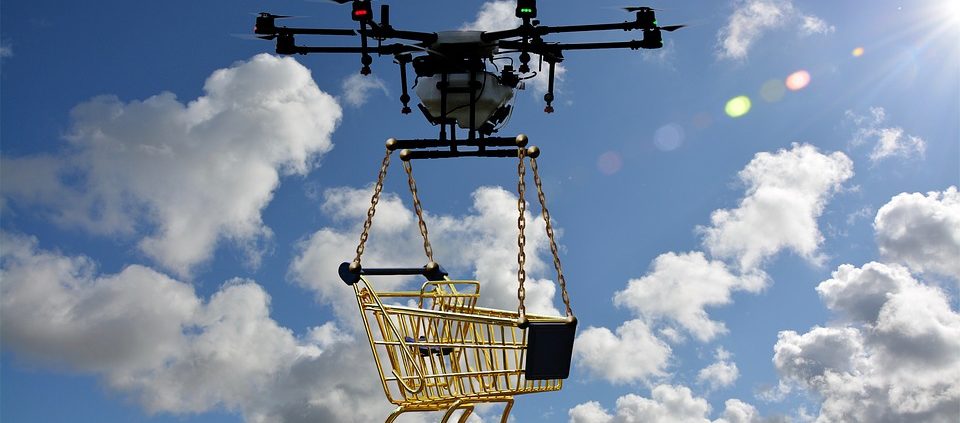Transportation of Merchandise by Drones, a Risky Activity
Transportation of Merchandise by Drones, a Risky Activity
The use of drones for professional purposes is a recent phenomenon that is rapidly expanding. This activity requires an adapted insurance coverage, while Europe is developing a new regulation framework.
For a few years, the distribution giants, such as Amazon or UPS have been developing more and more improved systems for delivering merchandise by drone. In France DPD Group (1) began a research project in partnership with Atechsys to deliver packages by drones, and this since 2014. After more than 600 test flights and the creation of a delivery safety terminal, DPD Group announced in 2016 having received the support of the Directorate General of Civil Aviation to deliver packages by drones on a 15 km regular line, linking Saint-Maximin-La*Sainte-Baume to Pourrières in the Var. In 2019, DPD Group announced that it had tested a second regular commercial line of delivery by drones between Grenoble (Isère) and a mountain village in the region that is difficult to access. If the recourse to drones for deliveries of merchandise is expected to develop and represent a considerable market, the legal framework of these types of operations in France and the transfer of risks to insurance remain to be examined.
The Framework of Merchandise Transportation Drone Flights
The two Orders dated 17 December 2015 (2) regulate the use of civilian drones, based on their use. During test flights, the applicable legal regime is that of experimentation (applicable to development flights or fine tuning the drone or its command system). Once the drone is fine-tuned, the applicable regulation to “private activities”, or for uses of drones referred to as “professional” is applied. The regulation covers four pre-defined use scenarios, referred to as “operational scenarios” (S1, S2, S3, and S4) for which the rules to follow are defined in detail (visual or non-visual flights, in inhabited area or uninhabited areas). Any flight outside of these four scenarios or by exemption to the applicable rules to these is not necessarily prohibited. However, only within the framework of a specific authorization, after studying case by case a justifiable file, may an acceptable level of safety be maintained. It is this specific authorization overriding the operational scenarios that is the case of package delivery by drone, due to the uniqueness and complexity of the mission.
However, these provisions are expected to change due to the introduction of a new European regulation. In fact, on 11 June 2019 the European Commission published two new European regulations relating to unmanned aircraft safety with the objective of standardizing the regulatory framework in Europe. (3). The European provisions relating to the use of unmanned aircraft will progressively apply starting on July 1st 2020. From now until then, the national framework in force remains applicable. From now on, the new European regulation provides for three categories of drone usage: the Open Category, the Specific Category and the Certified Category.
In practice, the current scenarios of particular activities will be converted into standard declarable scenarios, with differing conditions. Thus, the delivery of packages by drone should become easier as there will be a standardized regulation for all countries in the European Union. Furthermore, U-Space (European System aimed at guaranteeing the coexistence of drones with classic aviation) should contribute to reduce, when the time comes, the administrative formalities prior to the cross-border delivery by drone, subject to an adequate insurance coverage.
Insurance for Professional Drones in a Burgeoning Market
The growing use of drones represents a substantial source of risks (damaged drone or drone as the cause of damages), including in the case of potential illegal misuse for terrorist purposes). The BEA (The French Bureau of Inquiry and Analysis for Civil Aviation Safety) has notably reported several serious incidents involving drones, such as collisions with passenger planes that were barely avoided (BEA Report 2016 – 0395 and 2016-0098). There was also a case of a drone hitting two people during a festival (BEA Report 2019-0416). Therefore, it appears necessary to offer drone users an optimal insurance coverage.
The Order known as Conception dated 17 December 2015 does not specify per se the terms of drone insurance. This Order simply involves general European regulation in terms of aviation insurance, namely the Regulation (EC) No. 785/2004 related to the requirements in terms of insurance applicable to air carriers and aircraft operators. The DGAC (The French General Directorate of Civil Aviation) has confirmed that this insurance requirement applies to all professionally used drones. (4) Article 7 of this regulation stipulates that all aircraft operators must have a minimum guarantee of 750,000 DTS (Special Drawing Rights, SDR), that is around €1 Million.
The insurance industry offers numerous possibilities faced with the multitude of risks. Although classic coverage (civil liability (CL), bodily injury, tangible and intangible damage) may be mandatory, there also needs to be coverage related to more precise activities (professional civil liability (CL pro) for commercial activities with considerable financial stakes, such as the recurring transportation of merchandise), as well as insurance covering machinery breakdown (drones and payloads) and the risks of the privacy and personal data infringement Drone operators must carefully examine the insurance exclusion clauses.
The European Commission encourages the declaration of incidents linked to drones by remote pilots. In the future, filing these reports of incidents to the competent authorities will play a determining role for insurance companies in their analysis of risks, the basis on which the civil liability insurance premiums
will be established.
- LAURENT ARCHAMBAULT (SELENE AVOCATS): ATTORNEY IN PARIS; MEMBER OF THE COUNCIL FOR CIVILIAN DRONES
- CASSANDRA ROTILY: DOCTORAL CANDIDATE IN PUBLIC LAW UNIVERSITY OF HAUTE-ALSACE
Bibliography:
- International Network of package delivery of Geopost subsidiary Express Internationale of La Poste group.
- Order dated 17 December 2015 related to the use of airspace by unmanned aircraft JO 0298 dated 24 December 2015, p. 23898. Order dated 17 December 2015 related to the design of unmanned civilian aircraft in terms of their use and the required capacity of people that use them, JO No. 0298 dated 24 December 2015, p.23897
- Delegated regulation (EU) 2019/945 of the Commission dated 12 March 2019 related to unmanned aircraft systems and operators, from third party countries, of unmanned aircraft systems. Execution regulation (EU) 2019/947 of the commission dated 24 May 2019 concerning the rules and procedures applicable to operating unmanned aircraft.
- “L’assurance des drones décolle”, l’Argus de l’assurance dated 23 May 2016.
- Jean-Baptiste Charles, Pascal Dupont.« Drones civils – Notion, cadre et régime ».Jurisclasseur transport, fasc.962, 2018.
L’ARGUS DE L’ASSURANCE 29 No. 7633 DATED 22 NOVEMBER 2019



